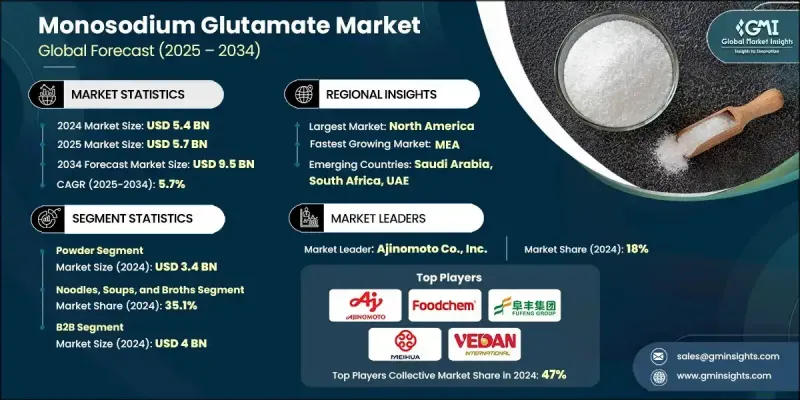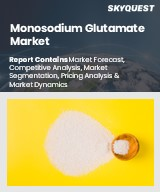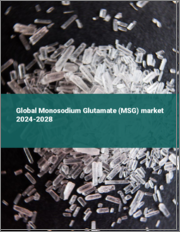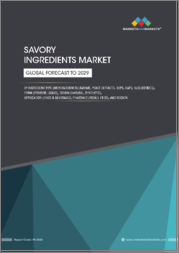
|
시장보고서
상품코드
1844356
세계의 글루타민산 나트륨(MSG) 시장 : 기회, 성장 촉진요인, 산업 동향 분석, 예측(2025-2034년)Monosodium Glutamate (MSG) Market Opportunity, Growth Drivers, Industry Trend Analysis, and Forecast 2025 - 2034 |
||||||
세계의 글루타민산 나트륨(MSG) 시장은 2024년 54억 달러로 평가되었으며 CAGR 5.7%로 성장해 2034년까지 95억 달러에 이를 것으로 추정됩니다.

글루타민산으로부터 유래된 나트륨염인 MSG는 다른 성분을 압도하지 않고 맛을 제공하는 능력에 의해 식품업계 전체에서 선호되는 향미 조미료로 계속되고 있습니다. 도시의 라이프 스타일 변화와 빠르고 맛있는 편리한 식품 옵션에 대한 수요의 급증이 성장을 뒷받침하는 동안 MSG의 사용은 기존 시장을 훨씬 뛰어 넘고 있습니다. 즉석식품, 인스턴트 식품, 대량 생산품이 식품 선반을 석권하는 동안 MSG는 안정된 맛을 유지하는데 중요한 역할을 하고 있습니다. MSG의 건강에 미치는 영향에 대한 신화는 점차 과학적 뒷받침의 안심감을 대체하고, 정보통의 세계 소비자층이 MSG를 받아들이기 시작하고 있습니다. 다문화적인 요리 동향 증가와 대담한 풍미를 초래하는 비용 효율적인 재료에 대한 요구가 함께, 수요는 더욱 가속화되고 있습니다. 스낵, 조미료 블렌드, 조리된 식품 등의 가공 식품 카테고리가 주요 성장 촉진요인이며, 저렴한 가격으로 대규모 풍미 강화를 실현하기 위해 외식산업이 MSG에 대한 의존도를 높이고 있습니다.
| 시장 범위 | |
|---|---|
| 시작 연도 | 2024년 |
| 예측 연도 | 2025-2034년 |
| 시장 규모 | 54억 달러 |
| 예측 금액 | 95억 달러 |
| CAGR | 5.7% |
분말 MSG 분야는 2024년 63.8%의 점유율을 차지했습니다. 세밀한 텍스처와 용해성으로 다양한 식품에 배합하기에 최적입니다. 스프, 조미료, 스낵 과자 모두에서 분말 MSG는 대규모 식품 제조에 필수적인 일관된 풍미 분포를 보장합니다. 다양한 식품 용도에 적응할 수 있기 때문에 산업용 및 업무용 최종 사용자를 대상으로 하는 생산자들 사이에서 선호됩니다.
국수, 수프, 죽 분야는 2024년에 17억 달러를 창출했으며 이러한 식품 가공 식품에서 MSG를 광범위하게 사용하는 데 도움이 됩니다. 도시의 소비자는 맛을 희생하지 않고 최소한의 준비로 끝나는 편리하고 빨리 먹을 수 있는 식사를 점점 선호하고 있습니다. MSG는 합리적인 가격으로 신뢰할 수 있는 방식으로 풍미를 높여 이 수요에 부응하고 있습니다. 식품 제조업체가 패스트푸드와 인스턴트 식품 분야에서 기술 혁신을 계속하면서 MSG는 친숙하고 만족감있는 맛을 제공하는 데 필수적인 성분입니다.
미국의 MSG 시장은 가공식품과 조리가 쉬운 식품의 소비 증가로 2024년 23억 달러로 평가됐습니다. 맛에 타협하지 않는 편리한 식사를 요구하는 소비자 수요가 MSG의 보급을 뒷받침하고 있습니다. USDA(미국 농무성)와 FDA(식품 의약품국) 등의 규제기관은 식품의 안전성과 클린 라벨 이니셔티브를 중시하는 것으로, 맛의 기대에 부응하면서도 제조의 투명성을 중시하도록 제조업체에 촉구하고 있습니다. 세계적인 요리와 건강 지향이면서 맛있는 식사에 대한 관심이 높아지는 가운데 MSG는 진화하는 미국의 음식 풍경 속에서 중요한 위치를 확보하고 있습니다.
세계의 글루타민산 나트륨(MSG) 시장의 주요 기업으로는 Ajinomoto Co., Inc., Fufeng Group, Great American Spice Company, Linghua Group, Vedan International (Holdings) Limited, Meihua Holdings Group Co., Ltd., Ningxia Eppen Biotech Co., Ltd., Prinova, Arshine Food Additives, Foodchem International 등이 포함됩니다. 시장에서의 존재감을 확고하게 하기 위해 MSG 업계의 기업은 다면적인 전략을 실시했습니다. 규제의 변화와 소비자의 선호도의 진화에 대응하기 위해 많은 기업들이 첨단 발효 기술과 클린 라벨 제조 방법에 투자하고 있습니다. 지역 생산 능력을 확대함으로써 제조업체는 공급 신뢰성을 높이면서 물류 비용을 줄일 수 있습니다. 대기업은 또한 유통망을 강화하고 주요 식품 가공업자와 장기적인 공급 파트너십을 맺고 있습니다. 이와 병행하여, 기업은 천연 발효 MSG 등 클린 라벨의 매력을 제공하는 제품 처방을 혁신하고 있습니다.
목차
제1장 조사 방법과 범위
제2장 주요 요약
제3장 업계 인사이트
- 생태계 분석
- 공급자의 상황
- 이익률
- 각 단계에서의 부가가치
- 밸류체인에 영향을 주는 요인
- 혁신
- 업계에 미치는 영향요인
- 성장 촉진요인
- 편리 식품 수요 증가
- 클린 라벨 제품으로의 전환
- 발효에서의 기술의 진보
- 음식 기호의 세계화
- 업계의 잠재적 위험 및 과제
- 천연 풍미 증강제와의 경쟁
- 저나트륨 대체품 수요 증가
- 시장 기회
- 지속가능성 주도 경쟁 우위성
- 신흥 섹터의 기회를 활용
- 지역의 취향에 맞는 맞춤형 맛 솔루션
- 성장 촉진요인
- 성장 가능성 분석
- 규제 상황
- 북미
- 유럽
- 아시아태평양
- 라틴아메리카
- 중동 및 아프리카
- Porter's Five Forces 분석
- PESTEL 분석
- 기술과 혁신의 상황
- 현재의 기술 동향
- 신흥기술
- 가격 동향
- 지역별
- 형태별
- 미래 시장 동향
- 기술과 혁신의 상황
- 현재의 기술 동향
- 신흥기술
- 특허 상황
- 무역 통계(HS코드)(참고 : 무역 통계는 주요 국가에서만 제공됨)
- 주요 수입국
- 주요 수출국
- 지속가능성과 환경 측면
- 지속가능한 관행
- 폐기물 감축 전략
- 생산에서의 에너지 효율
- 환경 친화적인 노력
- 탄소발자국의 고려
제4장 경쟁 구도
- 소개
- 기업의 시장 점유율 분석
- 지역별
- 북미
- 유럽
- 아시아태평양
- 라틴아메리카
- 중동 및 아프리카
- 지역별
- 기업 매트릭스 분석
- 주요 시장 기업의 경쟁 분석
- 경쟁 포지셔닝 매트릭스
- 주요 발전
- 합병과 인수
- 파트너십 및 협업
- 신제품 발매
- 확장 계획
제5장 시장 추계 및 예측 : 형태별, 2021-2034년
- 주요 동향
- 분말
- 과립
제6장 시장 추계 및 예측 : 용도별, 2021-2034년
- 주요 동향
- 국수, 수프, 죽
- 육류 제품
- 조미료 및 드레싱
- 기타
제7장 시장 추계 및 예측 : 유통 채널별, 2021-2034년
- 주요 동향
- B2B
- B2C
- 슈퍼마켓 및 하이퍼마켓
- 편의점
- 전문점
- 온라인 소매
- 기타
제8장 시장 추계 및 예측 : 지역별, 2021-2034년
- 주요 동향
- 북미
- 미국
- 캐나다
- 유럽
- 독일
- 영국
- 프랑스
- 스페인
- 이탈리아
- 기타 유럽
- 아시아태평양
- 중국
- 인도
- 일본
- 호주
- 한국
- 기타 아시아태평양
- 라틴아메리카
- 브라질
- 멕시코
- 아르헨티나
- 기타 라틴아메리카
- 중동 및 아프리카
- 사우디아라비아
- 남아프리카
- 아랍에미리트(UAE)
- 기타 중동 및 아프리카
제9장 기업 프로파일
- Ajinomoto Co., Inc.
- Arshine Food Additives
- Foodchem International
- Fufeng Group
- Great American Spice Company
- Linghua Group
- Meihua Holdings Group Co., Ltd
- Ningxia Eppen Biotech Co., Ltd
- Prinova
- Vedan International(Holdings) Limited
The Global Monosodium Glutamate (MSG) Market was valued at USD 5.4 billion in 2024 and is estimated to grow at a CAGR of 5.7% to reach USD 9.5 billion by 2034.

MSG, a sodium salt derived from glutamic acid, continues to be a preferred flavor enhancer across the food industry due to its ability to deliver the umami taste without overpowering other ingredients. Its usage has expanded well beyond its traditional markets as changing urban lifestyles and the surge in demand for fast, flavorful, and convenient food options fuel growth. As quick-serve meals, instant food, and mass-produced items dominate food shelves, MSG plays a vital role in maintaining consistent taste. A more informed and global consumer base has begun to embrace MSG, with myths about its health impact gradually being replaced by science-backed reassurance. The rise in multicultural culinary trends, coupled with the need for cost-effective ingredients that deliver bold flavor, further accelerates demand. Processed food categories such as snacks, seasoning blends, and ready meals are major growth drivers, along with the increasing dependence on MSG by the food service sector for affordable flavor enhancement at scale.
| Market Scope | |
|---|---|
| Start Year | 2024 |
| Forecast Year | 2025-2034 |
| Start Value | $5.4 Billion |
| Forecast Value | $9.5 Billion |
| CAGR | 5.7% |
The powdered MSG segment held a 63.8% share in 2024. Its fine texture and solubility make it ideal for blending into a variety of food products. Whether in soups, seasonings, or snacks, powdered MSG ensures consistent flavor distribution, which is crucial for large-scale food manufacturing. Its adaptability across different food applications continues to drive its preference among producers targeting both industrial and commercial end users.
The noodles, soups, and broth segment generated USD 1.7 billion in 2024, supported by the widespread use of MSG in these staple processed foods. Urban consumers increasingly gravitate toward convenient, ready-to-eat meals that require minimal preparation without sacrificing taste. MSG meets this demand by enhancing savory profiles in an affordable and reliable way. As food manufacturers continuously innovate within the fast food and instant meals segment, MSG remains an indispensable component for delivering a familiar and satisfying taste.
United States Monosodium Glutamate (MSG) Market was valued at USD 2.3 billion in 2024 due to rising consumption of processed and easy-to-prepare foods. Consumer demand for convenient meals that don't compromise on taste is driving widespread MSG adoption. Regulatory agencies such as the USDA and FDA, through their emphasis on food safety and clean-label initiatives, have prompted manufacturers to focus on production transparency while still meeting flavor expectations. With growing interest in global cuisines and health-conscious yet flavorful eating, MSG has secured a prominent place in the evolving American food landscape.
Key players in the Global Monosodium Glutamate (MSG) Market include Ajinomoto Co., Inc., Fufeng Group, Great American Spice Company, Linghua Group, Vedan International (Holdings) Limited, Meihua Holdings Group Co., Ltd., Ningxia Eppen Biotech Co., Ltd., Prinova, Arshine Food Additives, and Foodchem International. To solidify their market presence, companies within the MSG industry are implementing multi-faceted strategies. Many are investing in advanced fermentation technologies and clean-label production methods to cater to regulatory shifts and evolving consumer preferences. Expanding regional production capabilities helps manufacturers reduce logistics costs while enhancing supply reliability. Leading players are also strengthening distribution networks and entering long-term supply partnerships with large food processors. In parallel, firms are innovating product formulations that offer clean-label appeal, including naturally fermented MSG.
Table of Contents
Chapter 1 Methodology & Scope
- 1.1 Market scope and definition
- 1.2 Research design
- 1.2.1 Research approach
- 1.2.2 Data collection methods
- 1.3 Data mining sources
- 1.3.1 Global
- 1.3.2 Regional/Country
- 1.4 Base estimates and calculations
- 1.4.1 Base year calculation
- 1.4.2 Key trends for market estimation
- 1.5 Primary research and validation
- 1.5.1 Primary sources
- 1.6 Forecast model
- 1.7 Research assumptions and limitations
Chapter 2 Executive Summary
- 2.1 Industry 3600 synopsis
- 2.2 Key market trends
- 2.2.1 Form trends
- 2.2.2 Application trends
- 2.2.3 Distribution channel trends
- 2.2.4 Regional
- 2.3 TAM Analysis, 2025-2034
- 2.4 CXO perspectives: Strategic imperatives
- 2.4.1 Executive decision points
- 2.4.2 Critical success factors
- 2.5 Future Outlook and Strategic Recommendations
Chapter 3 Industry Insights
- 3.1 Industry ecosystem analysis
- 3.1.1 Supplier landscape
- 3.1.2 Profit margin
- 3.1.3 Value addition at each stage
- 3.1.4 Factor affecting the value chain
- 3.1.5 Disruptions
- 3.2 Industry impact forces
- 3.2.1 Growth drivers
- 3.2.1.1 Rising demand for convenient foods
- 3.2.1.2 Shift toward clean-label products
- 3.2.1.3 Technological advances in fermentation
- 3.2.1.4 Globalization of culinary tastes
- 3.2.2 Industry pitfalls and challenges
- 3.2.3 Competition from natural flavour enhancers
- 3.2.4 Rising demand for low-sodium alternatives
- 3.2.5 Market opportunities
- 3.2.5.1 Sustainability-driven competitive edge
- 3.2.5.2 Leveraging emerging sector opportunities
- 3.2.5.3 Customized flavour solutions for regional preferences
- 3.2.1 Growth drivers
- 3.3 Growth potential analysis
- 3.4 Regulatory landscape
- 3.4.1 North America
- 3.4.2 Europe
- 3.4.3 Asia Pacific
- 3.4.4 Latin America
- 3.4.5 Middle East & Africa
- 3.5 Porter’s analysis
- 3.6 PESTEL analysis
- 3.7 Technology and innovation landscape
- 3.7.1 Current technological trends
- 3.7.2 Emerging technologies
- 3.8 Price trends
- 3.8.1 By region
- 3.8.2 By form
- 3.9 Future market trends
- 3.10 Technology and innovation landscape
- 3.10.1 Current technological trends
- 3.10.2 Emerging technologies
- 3.11 Patent landscape
- 3.12 Trade statistics (HS code) ( Note: the trade statistics will be provided for key countries only)
- 3.12.1 Major importing countries
- 3.12.2 Major exporting countries
- 3.13 Sustainability and environmental aspects
- 3.13.1 Sustainable practices
- 3.13.2 Waste reduction strategies
- 3.13.3 Energy efficiency in production
- 3.13.4 Eco-friendly initiatives
- 3.14 Carbon footprint consideration
Chapter 4 Competitive Landscape, 2024
- 4.1 Introduction
- 4.2 Company market share analysis
- 4.2.1 By region
- 4.2.1.1 North America
- 4.2.1.2 Europe
- 4.2.1.3 Asia Pacific
- 4.2.1.4 LATAM
- 4.2.1.5 MEA
- 4.2.1 By region
- 4.3 Company matrix analysis
- 4.4 Competitive analysis of major market players
- 4.5 Competitive positioning matrix
- 4.6 Key developments
- 4.6.1 Mergers & acquisitions
- 4.6.2 Partnerships & collaborations
- 4.6.3 New product launches
- 4.6.4 Expansion plans
Chapter 5 Market Estimates and Forecast, By Form, 2021-2034 (USD Billion) (Kilo Tons)
- 5.1 Key trends
- 5.2 Powder
- 5.3 Granules
Chapter 6 Market Estimates and Forecast, By Application, 2021-2034 (USD Billion) (Kilo Tons)
- 6.1 Key trends
- 6.2 Noodles, soups, and broths
- 6.3 Meat products
- 6.4 Seasonings & dressings
- 6.5 Others
Chapter 7 Market Estimates and Forecast, By Distribution Channel, 2021-2034 (USD Billion) (Kilo Tons)
- 7.1 Key trends
- 7.2 B2B
- 7.3 B2C
- 7.3.1 Supermarkets and hypermarkets
- 7.3.2 Convenience stores
- 7.3.3 Specialty stores
- 7.3.4 Online retail
- 7.3.5 Others
Chapter 8 Market Estimates and Forecast, By Region, 2021-2034 (USD Billion) (Kilo Tons)
- 8.1 Key trends
- 8.2 North America
- 8.2.1 U.S.
- 8.2.2 Canada
- 8.3 Europe
- 8.3.1 Germany
- 8.3.2 UK
- 8.3.3 France
- 8.3.4 Spain
- 8.3.5 Italy
- 8.3.6 Rest of Europe
- 8.4 Asia Pacific
- 8.4.1 China
- 8.4.2 India
- 8.4.3 Japan
- 8.4.4 Australia
- 8.4.5 South Korea
- 8.4.6 Rest of Asia Pacific
- 8.5 Latin America
- 8.5.1 Brazil
- 8.5.2 Mexico
- 8.5.3 Argentina
- 8.5.4 Rest of Latin America
- 8.6 Middle East and Africa
- 8.6.1 Saudi Arabia
- 8.6.2 South Africa
- 8.6.3 UAE
- 8.6.4 Rest of Middle East and Africa
Chapter 9 Company Profiles
- 9.1 Ajinomoto Co., Inc.
- 9.2 Arshine Food Additives
- 9.3 Foodchem International
- 9.4 Fufeng Group
- 9.5 Great American Spice Company
- 9.6 Linghua Group
- 9.7 Meihua Holdings Group Co., Ltd
- 9.8 Ningxia Eppen Biotech Co., Ltd
- 9.9 Prinova
- 9.10 Vedan International (Holdings) Limited















